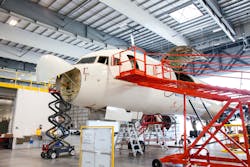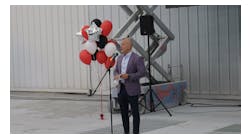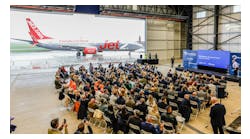It’s a great time to be in the MRO business, exclaims HAECO Americas’ President of Airframe Services Bill Collins.
“The growth in the aviation market is unprecedented and MROs are preparing for steady growth over the next decade,” he states.
The International Air Transport Association (IATA) recently released findings that support Collins’ assessment. IATA reports global passenger air traffic rose in 2018 by 6.5 percent as airlines transported more than 4.3 billion passengers and planes were fuller than ever. IATA forecasts another banner year in 2019.
Aircraft manufacturers also support Collins’ findings. In January, Boeing announced it set a record for jet deliveries in 2018, and a day later Airbus reported it had done the same. Both OEMs predict record deliveries for 2019, touting their backlog of orders as evidence.
This landscape prompts Stephen Lim, president of VT Aerospace, to describe the MRO business as dynamic and competitive. He explains: “Aircraft OEMs are setting records for the number of deliveries while air traffic continues to grow, which helps drive demand for MRO services. Continued profitability of airlines and increasing air travel is also driving demand for cabin interior upgrades.”
Further, Frank Berweger, vice president of corporate sales for Lufthansa Technik, expects MRO business to continue to grow, by at least 7 percent annually, in the years to come. He predicts the highest growth areas will be in engine services, component services, and digital MRO services.
With demand high for engine MRO and most shops operating at maximum capacity, Martin Friis-Petersen, senior vice president of MRO Programs at MTU Aero Engines, characterizes the market as “very positive.” But as Isaac Newton once said, “for every action, there is an equal and opposite reaction.” In this case, the opposite reaction is the challenges this time of prosperity presents.
Friis-Petersen explains, “MRO slot capacity is currently very tight worldwide as a result of various market forces. Shop visits will peak for the newer versions of V2500 and CFM56 engine families in the next two to five years — the V2500-A5, CFM56-5B, and CFM56-7. Demand for services for older legacy engines, such as the CF6-80C2, has continued longer than expected — thanks to low fuel prices and booming air transport demand, where demand for aircraft and engines is faster than delivery rates. Also, new generation engines are entering the shops earlier than originally anticipated and will ramp up in the next decades. All this has led to our shops being fully loaded worldwide.”
Competition is also heating up as “new entrants eye to get a piece of the pie as each newer generation of aircraft enjoys longer maintenance intervals,” states VT Aerospace’s Lim. He adds, “So, while demand is currently good, there are potential risks if the global economy deteriorates.”
Even so, Paul Dolan, chief operating officer of Aviation Technical Services (ATS), says: “It’s challenging, but challenging in a good way. Times are changing and change always brings opportunity. MROs are accustomed to being viewed as a commodity, a cost to be minimized year after year. But now we are seeing customers asking to partner more, acknowledging that MROs are ready and willing to ally with them on their headline goals — keeping planes flying, costs contained, and people safe.”
Growth Areas
“We are confident that the global MRO market will continue to grow in line with growth in traffic,” HAECO Americas’ Collins predicts. “We anticipate the MRO market to grow at about 4 percent a year over the next decade.”
Growth areas differ for each company, however. For instance, Todd France, vice president of business development for Airborne, sees huge growth opportunity in Tampa, FL. He reports Airborne has added capacity in Tampa to do checks at an online facility for its customers, thereby reducing overall downtime and cost for its customer base. The company also is growing service offerings at that location. Globally, France sees a strong North American market for its MRO services and expects that to continue into 2020.
Meanwhile, VT Aerospace’s Lim predicts bullish growth in all sectors of the Asian market. Lufthansa’s Berweger echoes Lim’s sentiments, “We estimate the Asia Pacific will pass the American MRO market in size within the next five years and stand out with the strongest fleet and MRO market.”
Friis-Petersen of MTU reports the Asian region is already No. 1 in the world for engine MRO volume in terms of revenue and produces around a quarter of all shop visits.
“As a consequence, Asia’s importance will continue to grow and will soon take over all other regions, also in terms of shop visits, which will represent over one-third of the world demand a decade from now,” Friis-Petersen says. “Within that region, China is the largest, single MRO market — both in shop visit volume and revenues. Because most visits are performed on narrow body engines, MTU Maintenance Zhuhai, the largest narrow body shop in Asia, is ideally positioned to serve this growth. We are increasing this facility by 50 percent to 450 shop visits by 2021.”
The Challenge of Limited Labor
As available work escalates, the number of skilled workers has not kept pace. International management consulting firm Oliver Wyman forecasts that U.S. commercial MRO maintenance demand will outpace the supply of the available U.S. workforce in 2023, putting pressure on already labor-challenged MROs.
ATS’ Dolan states: “There is a reason you read about the skilled labor shortage in the trade press every day — it is real and we’re feeling it at every site. Competition is intense within our industry — and from other industries — for skilled professional folks at every level. That competition plus the demographics of good people retiring, even retiring early, is a challenge that is not going to go away any time soon.”
Brian Sartain, senior vice president of the Repair and Engineering Group at AAR, reports the shortage of aircraft maintenance technicians is driving wages up, requiring AAR, and others, to work closely with their customer bases to ensure hourly rates increase in a managed way to maintain a viable business operation.
“There is never a better time than now for young people, women, veterans, or individuals looking for a change of career to get a job and training opportunities with the industry,” states VT Aerospace’s Lim.
Professional Development Programs
As the shortage of skilled workers grows, Airborne’s France states most MROs are getting creative in their efforts to attract a new generation to aviation.
“Airborne has been very proactive in this area and the results show that our investment is paying off,” he says. “This quarter marks the start of our 10th class in our Structures Apprentice Program. This provides unlicensed technicians with classroom and mentorship training that leads to their licensing.”
Airborne also offers an A&P test preparation course, provided in partnership with Ohio Means Jobs, which assists tenured employees in earning their A&P licenses.
“These programs, added to our Accelerated Advancement and Working Hero Program, consistently add skilled individuals to our workforce. We consider it our responsibility to maintain a highly trained workforce that can deliver consistent results for our customers,” France says.
VT Aerospace has taken similar measures. The company set up Workforce Development departments, beginning with its North American airframe maintenance operations, to create talent pipelines that sustain and grow its workforce. “The departments work closely with the local community, such as technical schools, secondary educational institutions, and transitioning military personnel to interest, recruit, and provide opportunities for individuals to join the aviation industry,” Lim says.
He adds other programs within VT Aerospace, such as its Airman Trainee Program, structures and interior internships, and a Military Fast Track Program, provide individuals with paid on-the-job training along with classroom training.
“[With these programs], we are already seeing an impact to our workforce and the communities we operate in,” he says. “Not only are we developing stronger relationships in our communities, we are seeing lives changing for the better. Because of these programs, job seekers that do not have the opportunity to attend an 18-month technical program, are able to receive an A&P license or be trained in a specialized skill.”
Collins reports HAECO Americas already felt the burn from the shortage of available mechanics and technicians. So, as the company prepped to open a new hangar and take on more work, it dedicated resources to improving internal training programs and updating and implementing technology that enables employees to effectively and efficiently complete their work.
“We continue this process to ensure we attract — and keep — top talent,” he says. “HAECO Americas has also been cultivating relationships within our communities and partnering with educational institutions to build a pipeline of new aircraft mechanics and technicians. We recently undertook an extensive review of employee engagement and retention best practices to ensure we build a stable workforce.”
Lufthansa Technik ramped up recruiting efforts, with the company actively recruiting junior staff and increasing the workforce. As part of this effort, the company launched comprehensive image campaigns with partners from the aviation industry. “There are various programs designed to spark interest in the aviation industry among children and young people,” Berweger says. “Special trainings, internships, and student programs are addressed at young professionals. The company also offers employees a range of internal training measures and incentive benefits like sabbaticals or coachings to increase Lufthansa’s attractiveness as an employer.”
ATS also saw the shortage coming. Dolan credits its human resources team for taking decisive action as soon as it saw attrition growing. The company adjusted pay scales, which he says had an immediate impact on recruiting and attrition.
“Long-term, however, this won’t be enough,” Dolan adds. “Through our ATS Academy, we’re overhauling the way we onboard, train, progress, and compensate people, giving them trajectory and choice in managing their careers. Our leaders on the floor are instrumental in making these changes work day to day, and we’re hearing good things back from them as we roll out the new elements. For example, we just launched the ATS Apprenticeship Program, which is a new initiative aimed at attracting talent and growing the pipeline of industry-leading professional aviation mechanics.”
In 2018, AAR created a vice president of workforce development position and hired Ryan Goertzen (former president of Aviation Technician Education Council (ATEC)) to enhance its existing programs and partnerships and identify new ones. Sartain reports, “He developed a maintenance career path for AAR that is advanced through industry skills credentials and EAGLE Pathway was born.”
AAR launched its EAGLE Career Pathway program at colleges in five cities near its maintenance facilities and global headquarters in October 2018. It expects to open two more programs in the months to come. The curriculum enhances instruction and job experience for students, and includes mentoring, job shadowing, and academic support. Students who complete this program are guaranteed an interview with AAR.
The program also includes a 300-hour aviation sheet metal course at Chicago’s Olive-Harvey College. The course, being introduced in March, is being held at the college’s new Aviation Futures Training Center, made possible because of AAR’s partnership with the Chicago mayor’s office and the City College of Chicago. Composites and aviation electronics courses will phase in over the next two years.
Students participating in these offerings and pursuing A&P certificates can receive up to $15,000 in tuition reimbursements from AAR. The company also belongs to a state workforce development program in Indiana that awards training grants of up to $50,000 to students enrolled in the aviation maintenance training program at AAR partner, Vincennes University.
A Global View to Labor
Though individual companies are aggressively tackling the labor shortage, Lufthansa’s Berweger notes it must be addressed globally, as well. He believes the MRO industry must become better at attracting new talents and skilled workers by improving working conditions and salaries. He adds: “We can increase efforts to free our workforce from routine work, which could also be done by robots/artificial intelligence to enable them to focus on the kinds of work where their skills are essential. Finally, the industry should also increase its partnerships with schools and universities to increase the interest of young people for the fascinating industry at a very early stage of their life.”
AAR’s Sartain agrees, “The shortage of maintenance workers isn’t limited to one region or company; it’s a global issue. But the industry is making strides, lobbying successfully last year to have updates to FAA training protocols and provisions of workforce legislation focused on education and training included in the FAA Reauthorization Bill. It includes employer training grants of up to $500,000 through 2023.”
According to Sartain, the industry must continue down the path set by individual companies by developing partnerships that enhance the workforce and by developing strategic pathways into MROs.
“We need to work together to support initiatives like ATEC’s Choose Aerospace campaign,” he says. “This brings the collective resources of the entire industry together to focus on workforce development and growing the next generation of aerospace workers. The workforce challenge is a national and global issue that can only be solved by working together to help grow the pipeline of students choosing an aerospace profession.”
Finally, Sartain points out there must be a focus on bringing underrepresented populations into aviation. “Minorities and women must be the focus as we grow the technician pipeline,” he says. “Programs like AAR’s partnerships with Olive Harvey, in which the first cohort of students scheduled to start in April is 100 percent minority and 25 percent women, is an example of what we must do to move the needle in the right direction.”
Ronnie Wendt owns In Good Company Communications and has been writing about aviation since 2009. She resides in Waukesha, WI.



